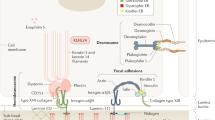Abstract
Epidermolysis bullosa simplex (EBS) is caused by keratin 5 and 14 mutations. In vitro studies revealed that susceptibility to caspase 8-mediated apoptosis is increased in keratin 14 mutated keratinocytes. We aimed to investigate the role of apoptotic/inflammatory pathways in the pathogenesis of EBS by studying the expression of caspase 8 in lesional and non-lesional skin compared to controls. Ten EBS patients proved by electron microscopy and five age and sex matched healthy volunteers were the subjects of this case control study. Caspase 8 expression was studied by immunohistochemistry. Caspase 8 expression in lesional and non-lesional skin was significantly higher than in controls (p < 0.01 and p = 0.013, respectively) with no significant difference between lesional and non-lesional skin. Lesional skin had significantly higher density of dermal infiltrate (p = 0.02). Caspase 8 expression in lesional skin was significantly correlated with the extent of the disease, rate of blistering, and density of dermal infiltrate (r = 0.835; p = 0.003, r = 0.889; p = 0.001 and r = 0.776; p = 0.008 respectively). Caspase 8-mediated apoptosis is an integral component of an orchestra of events conducted by keratin mutation. Apo-cytolysis is proposed to better describe the mechanism of blistering in EBS. The small number of cases is a limitation.





Similar content being viewed by others
Abbreviations
- EBS:
-
Epidermolysis bullosa simplex
- EB:
-
Epidermolysis bullosa
- K:
-
Keratin
- TNF-α:
-
Tumor necrosis factor alpha
- TNFR1:
-
Tumor necrosis factor receptor type 1
- TRADD:
-
Tumor necrosis factor receptor type1-associated DEATH domain
- NFJS:
-
Naegeli–Franceschetti–Jadassohn syndrome
- IL:
-
Interleukin
- K5−/− :
-
Keratin 5 null
References
Bernett L, Johnson J, Paul H (2009) Congenital diseases (Genodermatoses). In: Elder DE, Elenitasas R, Johnson BL, Murphy GF, Xu X (eds) Lever’s Histopathology of the skin, 9th edn. Lippincott Williams & Wilkins, Philadelphia, pp 152–153
Bossaller L, Chiang PI, Schmidt-Lauber C, Ganesan S, Kaiser WJ, Rathinam VA, Mocarski ES, Subramanian D, Green DR, Silverman N, Fitgerald KA, Marshak-Rothstein A, Latz E (2012) Cutting edge: FAS (CD95) mediates noncanonical IL-1β and IL-18 maturation via caspase-8 in an RIP3-independent manner. J Immunol 189:5508–5512
Bradley JR (2008) TNF-mediated inflammatory disease. J Path 214:149–160
Fine JD, Eady RAJ, Bauer EA, Bauer JW, Bruckner-Tuderman L, Heagerty A, Hintner H, Hovnanian A, Jonkman MF, Leigh I, McGrath JA, Mellerio JE, Murrell DF, Shimizu H, Uitto J, Vahlquist A, Woodley D, Zambruno G (2008) The classification of inherited epidermolysis bullosa (EB): report of the Third International Consensus Meeting on diagnosis and classification of EB. JAAD 48:931–950
Grando SA, Bvstrvn JC, Chemvavsky AI, Frusic’-Zlotkin M, Gniadecki R, Lotti R, Milner Y, Pittelkow MR, Pincelli C (2009) Apoptolysis: a novel mechanism of skin blistering in pemphigus vulgaris linking the apoptotic pathways to basal cell shrinkage and suprabasal acantholysis. Exp Dermatol 18(9):764–770
Irvine AD (2005) Inherited defects in keratins. Clin Dermatol 23:6–14
Lu H, Chen J, Planko L, Zigrino P, Klein-Hitpass L, Magin TM (2007) Induction of inflammatory cytokines by a keratin mutation and their repression by a small molecule in a mouse model for EBS. J Invest Dermatol 127:2781–2789
Lugassy J, McGrath JA, Itin P, Shemer R, Verbov J, Murphy HR, Ishida-Yamamoto A, Digiovanna JJ, Bercovich D, Karin N, Vitenshtein A, Uitto J, Bergman R, Richard G, Sprecher E (2008) KRT14 haplo insufficiency results in increased susceptibility of keratinocytes to TNF-alpha-induced apoptosis and causes Naegeli–Franceschetti–Jadassohn syndrome. J Invest Dermatol 128:1517–1524
Pirnia F, Schneider E, Betticher DC, Borner MM (2002) Mitomycin C induces apoptosis and caspase-8 and -9 processing through a caspase-3 and Fas-independent pathway. Cell Death Differ 9:905–914
Russell D, Paul DA, James J, Lane B (2004) Mechanical stress induces profound remodeling of keratin filaments and cell junctions in epidermolysis bullosa simplex keratinocytes. J Cell Sci 117:5233–5243
Russell D, Ross H, Lane B (2010) ERK involvement in resistance to apoptosis in keratinocytes with mutant keratin. J Invest Dermatol 130:671–681
Weedon D (2010) Weedon’s skin pathology, 3rd edn. Churchill Livingstone, Oxford, pp 143–146
Yoneda K, Furukawa T, Zheng YJ, Momoi T, Izawa I, Inagaki M (2004) An autocrine/paracrine loop linking keratin 14 aggregates to tumor necrosis factor- mediated cytotoxicity in a keratinocyte model of epidermolysis bullosa simplex. J Biol Chem 279:7296–7303
Acknowledgments
We thank all the residents of the Dermatology Department for helping us in the collection of cases. We also thank Tarek Diab, MD, consultant of tropical medicine, Theodor Bilharz Research Institute, Cairo, Egypt for performing the statistical work.
Conflict of interest
The authors have no conflicts of interest to declare.
Ethical standard
The research was approved by the Department Ethical Committee.
Author information
Authors and Affiliations
Corresponding author
Rights and permissions
About this article
Cite this article
El-Hawary, M.S., Abdel-Halim, M.R.E., Sayed, S.S. et al. Apocytolysis, a proposed mechanism of blister formation in epidermolysis bullosa simplex. Arch Dermatol Res 307, 371–377 (2015). https://doi.org/10.1007/s00403-015-1560-4
Received:
Revised:
Accepted:
Published:
Issue Date:
DOI: https://doi.org/10.1007/s00403-015-1560-4




